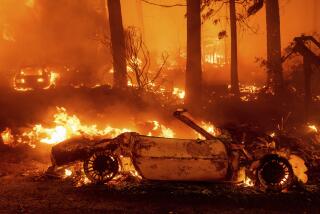Satellite Photos of Shuttles Planned
- Share via
WASHINGTON — A federal intelligence agency has agreed to a NASA request to take satellite pictures of space shuttle flights, seeking to quell controversy over why such images were not obtained during Columbia’s final mission, the space agency’s top official said Friday.
NASA Administrator Sean O’Keefe announced the agreement with the National Imagery and Mapping Agency days before the expected release of a new collection of e-mail documenting the significant debate within the space agency about the shuttle’s safety days before it disintegrated on Feb. 1.
O’Keefe said the e-mails would show some NASA personnel “pleading” for more information -- such as photographs from what he called national security “assets” -- to help assess potential damage to the shuttle shortly after its Jan. 16 liftoff.
At the time, NASA and its contractors were trying to determine the effect of debris that had fallen from an external fuel tank and struck the shuttle’s left wing. But O’Keefe said the e-mails reinforce his conclusion that there was consensus by the mission’s end that the shuttle was not at risk, meaning there was no urgent need to request pictures from other U.S. agencies.
O’Keefe, in a news conference at NASA headquarters, declined to second-guess that conclusion. “I’m not ever engaging in ‘shoulda,’ ‘coulda,’ ‘woulda,’ ” he said.
“We’ll never end up settling this debate” over whether information from military telescopes or satellite pictures would have alerted NASA to grave trouble, O’Keefe said. But he added the new arrangement with the mapping agency would “remove ambiguity” about requests for such information in the future.
Despite the Columbia disaster, NASA officials are forging ahead with plans to keep the shuttle flying until at least 2015 and possibly several years longer. One of the three remaining crafts could be launched as early as next fall, O’Keefe has said.
Columbia’s seven astronauts died when the orbiter broke up during reentry into Earth’s atmosphere. An accident investigation board appointed by NASA is examining the accident.
On Friday, NASA employees mourned two new deaths related to the accident: a Texas state employee and a helicopter pilot who died while searching for Columbia’s wreckage. Killed in the Thursday helicopter crash in East Texas were Charles Krenek, 48, of the Texas Forest Service, and pilot Jules F. “Buzz” Mier Jr., 56, of Arizona.
The government had hired the helicopter to help with the search.
Three other passengers were hospitalized with injuries after the crash, said Gay Ippolito, a spokeswoman for the U.S. Forest Service in Texas.
Matt Tschacher of the U.S. Forest Service was listed in fair condition; Richard Lange of the United Space Alliance at Kennedy Space Center in Florida was in fair condition; and Ronnie Dale, a NASA employee from Kennedy Space Center, was in serious condition with what O’Keefe said was a punctured lung.
The helicopter was one of 28 being used to canvass 550,000 acres for shuttle wreckage in a recovery effort involving dozens of state, local and federal agencies. So far, about a quarter of the shuttle’s weight has been found, most of it in East Texas. That amounts to 58,000 pounds of debris.
O’Keefe expressed space agency employees’ sorrow at “this particular latest tragedy in a larger tragic story.”
He said the helicopter was flying in good weather when its engines apparently stopped, according to two fishermen who witnessed the crash. “It took a nose dive,” O’Keefe said.
In another development, O’Keefe noted that the Russian space agency has scheduled an April 26 launch for a Soyuz spacecraft to carry a new crew to the international space station.
The crew, one U.S. astronaut and one Russian cosmonaut, will replace three men now on the station. The trio had been scheduled to return to Earth this month in a space shuttle. But the three remaining shuttles have been grounded since the Columbia disaster.
O’Keefe said discussions continue among the United States, Russia and 14 other nations over how to pay for additional missions to support the space station while the shuttles are out of service.
More to Read
Sign up for Essential California
The most important California stories and recommendations in your inbox every morning.
You may occasionally receive promotional content from the Los Angeles Times.













